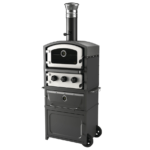Why Is Pizza So Expensive Now In the UK And Other Places?
Pizza is undeniably one of the world’s most beloved dishes.
But its cost has some people scratching their heads. From restaurant pizzerias to takeaway services, pizza prices are often higher than expected in the UK, prompting many to wonder why this classic dish is so expensive now.
If you’re wondering the same thing, then this short guide will walk you through the root causes of it, and how you can cope with them.
Why Is Pizza So Expensive Now In the UK?
Pizza prices in the UK have been driven up mostly by rising inflation, higher operating costs, and an increased demand for delivery services and takeaway meals. They’re also compounded by high business rates and rental fees, as well as stricter standards for ingredients and quality.
Inflation And Rising Operating Costs
The UK pizza industry is facing increased costs due to rising operating expenses, as well as external factors such as import tariffs and export duties. This has led to a marked increase in the cost of production for both independent pizzerias and large chains.
High energy prices are pushing up the costs of everyday foods like pasta and bread, which provide key ingredients in many pizzas. Additionally, labour payment rates have gone up significantly over the years with minimum wage increases, resulting in higher costs for businesses that employ their staff on hourly wages.
Increased Demand For Delivery And Takeaway Services
The UK restaurant industry has experienced a boom in the last few years, with the increasing demand for food delivery and takeaway services driving growth. This is due to the convenience offered by these services which makes it easier for people to enjoy restaurant-quality meals without having to physically go out or make their own food.
However, higher prices tend to come with more convenience, and this is certainly true when it comes to pizza; as pizzerias struggle with rising operating costs such as rent and business rates, they have had a turn to slightly mark up their prices in order to remain profitable– often resulting in customers paying almost double what they would pay if dining in.
Delivery platforms can also add fees to orders which increases pricing even further. In addition, many pizzerias are now investing in higher quality ingredients while also bumping up packaging costs associated with takeaways – thus driving up prices still further.
High Rent And Business Rates
The high cost of pizza in the UK is due, in part, to escalating rental and business costs. As operating expenses and overhead costs such as rent and equipment are consistent factors in pricing for fast-food restaurants like pizza chains, businesses located in areas with higher rental prices face more difficulty managing their budget.
Meanwhile, the thriving takeaway industry furthers these means of overhead expenditure.
With competition from big chains on delivery services such as Deliveroo or Just Eat proving difficult to compete against; it’s clear that small independent pizzerias often struggle against larger establishments when competing for customers via this medium – especially since large chain stores often offer discounts and deals where local shops tend not too.
This can make it difficult for smaller businesses to keep up without inflating customers bills.
Ingredient Costs And Quality Improvement
Pizza prices in the UK have increased over time due to a range of factors, including rising labour, overhead, and ingredient costs. Inflation is one of the main contributors to these higher pizza prices; higher fuels costs and labour wages also contribute to this trend.
Increased demand for delivery and takeaway services is another factor driving up costs.
The quality and quantity of ingredients used in making traditional pizzas can also add significantly to their overall cost.
Costly cheese varieties like Buffalo Mozzarella or Parmesan can constitute a significant portion of each pizza’s price tag when high-standard mozzarella isn’t used instead – especially if recipes include more than one premium topping such as pepperoni or prosciutto ham slices.
Additionally, vegetable toppings such as artichokes or olives may need marinating before use which could push up costs even further.
Impact Of High Pizza Prices On Consumers And Pizza Business Owners

Reduced Sales For Pizza Businesses
The rising cost of pizza has had a major effect on sales for businesses in the UK. Due to increased inflation, high rent and business rates, and the costs associated with quality ingredients, pizzerias are facing tighter margins than ever before.
Additionally, delivery and takeaway services have seen skyrocketing demand from consumers that generally include significant fees taken off the top of each sale.
Competition is also an important factor when considering how higher prices impact reduced sales for pizza businesses. Increased competition from online ordering apps can create pressure on local independent restaurants that cannot compete in terms of pricing or convenience against larger corporate chains.
Furthermore, changing consumer preferences are playing a role as people move away from traditional Italian-style pizzas in favour of more innovative offerings such as gourmet toppings or exotic flavours resulting in higher operating costs for restaurants yet even less willingness to pay premium prices by customers looking to get more bang for their buck.
Negative Effect On Consumers’ Budgets
In the face of rising prices, it is becoming increasingly difficult for households to purchase their favourite pizza at an affordable price. With inflation on food items and commodities up, combined with higher labour costs and business rates, pizza sales have taken a hit as consumers are pushed towards cheaper alternatives such as frozen pizzas.
Due to this increase in prices, the budget constraints of consumers may well be stretched beyond what is comfortable. The knock-on effect of overextended budgets can lead to financial insecurity – causing stress on both customers and restaurants alike long term.
It has become necessary for households to weigh up their incomes against expenditure – where possible seeking cheaper options instead when dining out or ordering takeaways such as pizza that come with sizable price tags attached.
What Are The Options For Affordable Pizzas?
Making Homemade Pizzas
Making homemade pizza can be an affordable option for indulging in the Italian delicacy.
At the heart of making a delicious pizza is your dough – this will decide whether you have a fluffy crust or a crunchy base. But with many different varieties available, ranging from white flour through to gluten-free options, discover which one suits both your wallet – and palate! – shouldn’t be too hard.
Toppings are then free for you to customize: fresh vegetables, inventive meats or even unexpected ingredients such as olives; they are yours for the choosing — based on what’s in season and on offer at lower-priced grocers.
Alternatives do exist for making homemade pizzas less expensive still but require more up-front investments – such as purchasing an at-home oven capable of authentic Italian cooking (with prices ranging from £100 all the way up to £1000+).
Supporting Local And Independent Pizzerias
The British pizza industry is worth billions of pounds, but for local and independent pizzerias operating in the UK, a business can be challenging. Competition from big-name chains means that the costs of running a small effective operation are high – rent, business rates, ingredient costs and delivery fees all add up.
With these factors in mind, it’s easy to understand why pizza has become increasingly expensive.
Local eateries offer an alternative to bigger brands with delicious specialities crafted by people who are passionate about food. Not only is this beneficial for customers but helps to keep traditional cooking styles alive and provide employment opportunities for local people too!
Pizzerias can also put on fundraising events and collaborate with fellow artisans or suppliers to help build networks within the community as well as engage directly with their customers via social media marketing campaigns which encourages healthy dining habits at affordable prices.
This is particularly beneficial for lowincome families who may have difficulty accessing quality food otherwise.
Taking Advantage Of Deals And Discounts
Discounts and promotions are a great way to get more bang for your buck when it comes to pizza. Pizza restaurants and pizzerias utilize deals, coupons, and pizza codes as they are irresistible for customers.
Popular chains like Domino’s offer exclusive discounts while local independent outlets offer vouchers that can be used in-store or through apps. Promotions often have time constraints so customers need to take advantage quickly – some services even allow customers to order discounted ‘meals of the day’ on select days of the week.
Discounted meals also help smaller businesses compete with larger brands by offering unbeatable prices within certain areas. Rewarding fierce loyalty is one strategy adopted by many restaurants; loyalty programs enable frequent buyers and companies seeking long-term relationships both benefitting from numerous rewards such as free desserts, discounts and two-for-one offers over extended periods of time.
Conclusion
Pizza may be expensive, but it’s still one of the most beloved and popular foods in the UK. Its high cost is due to a variety of factors including inflation, ingredient costs, labour fees, demand for fast delivery service, and rising rent prices.
But there are ways to enjoy pizza without breaking the bank such as making homemade pizzas with ingredients bought at a lower cost or supporting local and independent pizzerias who offer discounts and deals.






